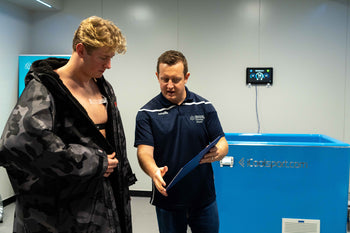4 Minuten Lesezeit
Earlier this year Manchester Metropolitan University (MMU) Institute of Sport, a global leader in the academic study of sports science, undertook a research study to investigate the effects of wearing a dryrobe® Advance changing robe after cold water immersion.
Their results show that wearing a dryrobe® Advance after getting out of cold water can have significant benefits, including helping to lower heart rate and increase skin temperature. Find out more about this independent study…
After getting out of cold water, warming up quickly is vital. The human body is able to regulate its own temperature pretty well, but doesn’t cope with big changes in core body temperature. In cold water, the body can lose heat quickly. Water is 25 times more conductive than air, so it strips heat away from the body very quickly.
Whilst swimming or surfing, the body is generating heat and can maintain its core temperature pretty well. As soon as you get out of the water and stop exercising you stop producing heat and your body temperature can plummet very, very rapidly. This is often referred to as ‘After Drop’. Failure to warm back up properly can not only hamper recovery, but can also be dangerous, potentially leading to hypothermia.

The dryrobe® Advance changing robe has been designed to help you warm up as quickly as possible. The unique synthetic lambswool lining locks in warmth and wicks water away from your skin into the pile of the fabric, helping you dry quickly. The weatherproof outer layer protects you from the elements (rain, wind, snow) that would cause your temperature to continue to drop.
So sure of its ability to warm you up after a cold water session we decided to put the dryrobe® Advance to the test!
This independent research study by MMU measured both physiological (core body temperature, heart rate and skin temperature) and perceptual (thermal sensation and thermal comfort) responses of participants and was the first study to be conducted at their new, state-of-the-art Institute of Sport building.

Dr Dale Read and Dr Gethin Evans created a randomised, repeated measures experiment for the study which ensures there is no bias to the order of conditions. Participants attended the laboratory on three different occasions and were randomly assigned to one of the three conditions (dryrobe® Advance, towel, foil space blanket). Core body temperature was measured using an ingestible telemetric pill, skin temperature using wireless iButtons and heart rate using a Polar chest strap monitor. Baseline data was recorded before participants were immersed in cold water (14°C) for 30 minutes.

Once participants exited the water, they were then provided with either a dryrobe® Advance, a towel, or a foil space blanket. To simulate the conditions following open water swimming, participants were then positioned in front of fans to replicate wind speed (10 mph) for 15 minutes. All data was collected in standardised environmental conditions.

The results from the study show:
- Wearing a dryrobe® Advance following cold water immersion was statistically proven to be more effective in decreasing heart rate amongst participants.
- Skin temperature was statistically higher after the first two minutes of wearing a dryrobe® Advance, demonstrating that the body warms up faster compared to using other garments, helping to mitigate the dangers of hypothermia and ‘After Drop’.
- Participants’ thermal comfort and thermal sensation levels were statistically higher when wearing the dryrobe® Advance, demonstrating that participants felt warmer and more thermally comfortable when wearing the dryrobe®.
The rapid recovery demonstrated by these results shows that the dryrobe® Advance is potentially beneficial to athletes performing repeatedly over a short period of time, such as swimmers or surfers training, or competing in events.

The study statistically concludes that there are significant benefits in terms of safety and lower cardiovascular demand if a dryrobe® Advance is worn after getting out of cold water, as well as improving recovery and performance in certain sports.
Find out more about MMU Institute of Sport:
mmu.ac.uk/institute-of-sport
Published on October 31, 2022
